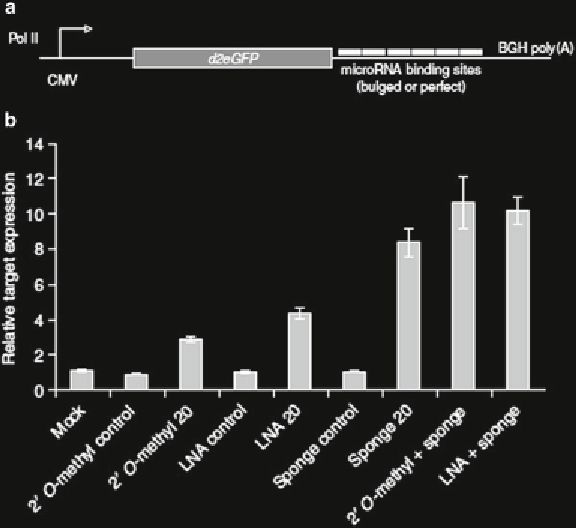Biology Reference
In-Depth Information
Fig. 13
Increased effi ciency of miRNA sponges relative to traditional targeting of
miRNAs. (
a
) miRNA sponge construct containing several miRNA-binding sites
specifi c for miRNA seed family that were either exactly complementary or
bulged. These constructs were co-transfected with a luciferase reporter plasmid
with the complementary to the sponge sites. (
b
) Luciferase target suppression
using a variety of miRNA inhibitory oligonucleotide strategies. Co-transfection
with sponge constructs resulted in a signifi cantly higher degree of miRNA inhibi-
tion than obtained with traditional oligonucleotide inhibitors. Image adapted with
permission from Ebert MS et al. (2007) Nat Met
oligonucleotide with a fl uorescent and photoreactive linker abrogat-
ing its silencing ability. The lys-6 miRNA in
C. elegans
was selected
as a target due to its role in right/left asymmetric differentiation in
the nervous system (Fig.
14
). After optimization of the length of the
blocking oligonucleotide, the antisense agents were injected into the
gonad of adult worms, and miRNA activity was knocked down at
various time points during larval development to assess when lys-6
miRNA was active in nervous system development. This approach
was successful, as inactivation before comma phase led to a complete
knockout phenotype, while activation at any timepoint after the
comma phase had no phenotypic effect, demonstrating that lys-6 is
only truly essential in early development. This extension of antisense
technology is useful in illustrating the importance of miRNAs not
only in diseases but also within a developmental context.
A recent advancement in the silencing of miRNA in vitro and
in vivo includes the integration of synthetic DNA strands with

